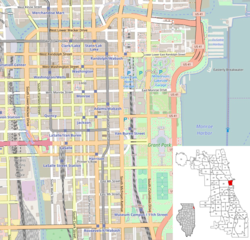Rookery Building
|
Rookery Building
|
|

(1891)
|
|
| Location | 209 South LaSalle Street Chicago, IL |
|---|---|
| Coordinates | 41°52′44.7″N 87°37′55.6″W / 41.879083°N 87.632111°WCoordinates: 41°52′44.7″N 87°37′55.6″W / 41.879083°N 87.632111°W |
| Built | 1886 |
| Architect | Burnham & Root; Frank Lloyd Wright; William Drummond; et al. |
| Architectural style | Chicago |
| NRHP Reference # | 70000238 |
| Significant dates | |
| Added to NRHP | April 17, 1970 |
| Designated NHL | May 15, 1975 |
| Designated CL | July 5, 1972 |
The Rookery Building is a historic landmark located at 209 South LaSalle Street in the Loop community area of Chicago in Cook County, Illinois, United States. Completed by John Wellborn Root and Daniel Burnham of Burnham and Root in 1888, it is considered one of their masterpiece buildings, and was once the location of their office. The building measures 181 feet (55 m), is twelve stories tall and is considered the oldest standing high-rise in Chicago. It has a unique style with exterior load-bearing walls and an interior steel frame, which provided a transition between accepted and new building techniques. The lobby was remodeled in 1905 by Frank Lloyd Wright. Beginning in 1989, the lobby was restored to the original Wright design.
The building was designated a Chicago Landmark on July 5, 1972, and was added to the National Register of Historic Places on April 17, 1970 and listed as a National Historic Landmark on May 15, 1975.
The name of the building is an allusion to the old City Hall building that occupied the land before the Rookery. That building was nicknamed the Rookery not only in reference to the crows and pigeons that inhabited its exterior walls, but also because of the shady politicians it housed (given the rook's perceived reputation for acquisitiveness). After the Great Chicago Fire a dilapidated building was used as an interim City Hall at this location (LaSalle and Adams). However, pigeons became such a nuisance that a complaining citizen began referring to the building as "a rookery", a term the press quickly adopted. Although several names were considered when a new structure on the site was proposed, "the Rookery" won out.
...
Wikipedia

